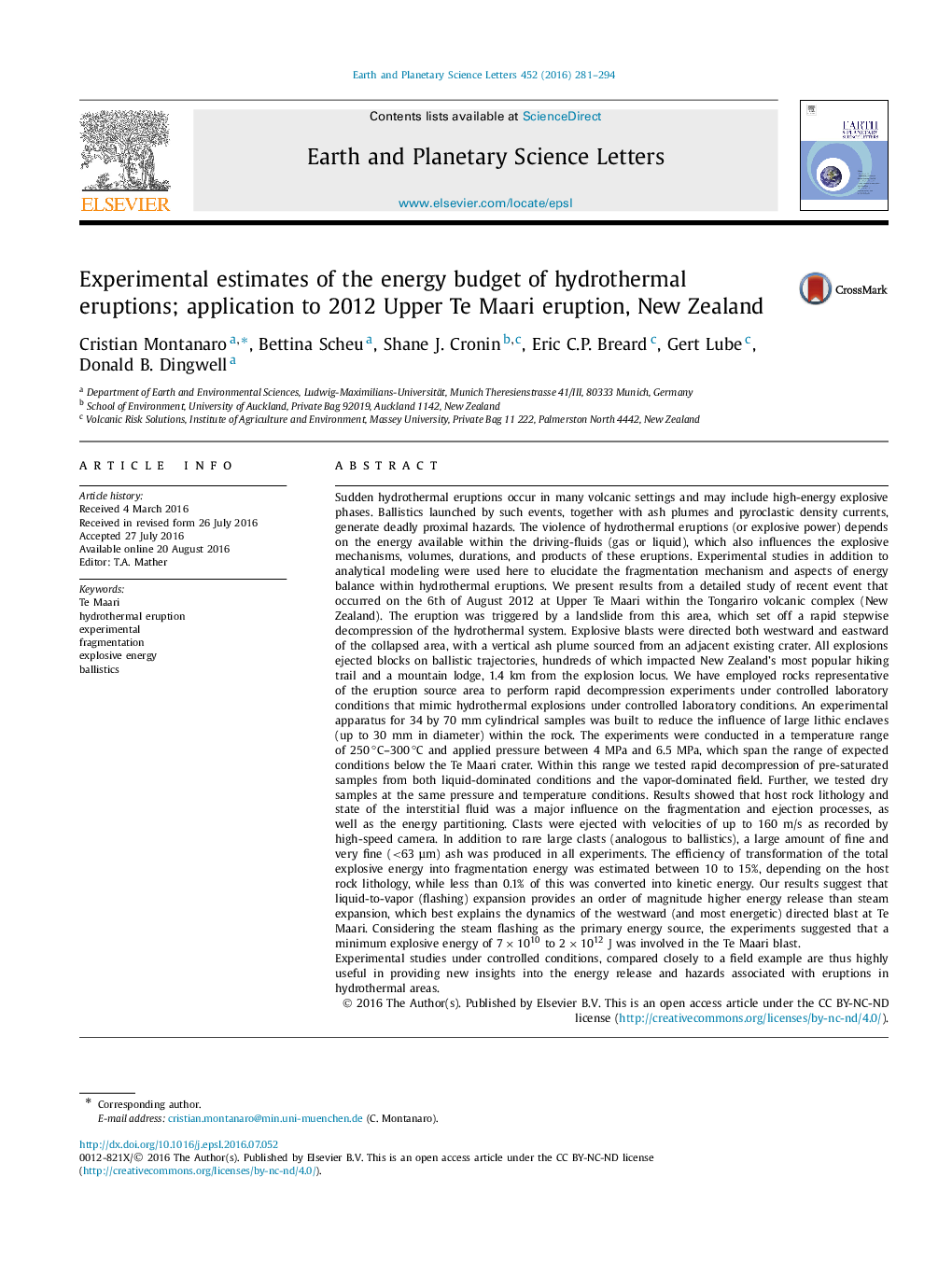| کد مقاله | کد نشریه | سال انتشار | مقاله انگلیسی | نسخه تمام متن |
|---|---|---|---|---|
| 6427131 | 1634704 | 2016 | 14 صفحه PDF | دانلود رایگان |

- Experimental studies to unravel the hydrothermal eruptions energetics.
- Effect of energy source and rock heterogeneity on the fragmentation behavior.
- Steam flashing versus steam expansion as source of explosive energy.
- Energy partitioning between fragmentation work and kinetic energy of ejecta.
- Ballistic formation from heterolithic rocks.
Sudden hydrothermal eruptions occur in many volcanic settings and may include high-energy explosive phases. Ballistics launched by such events, together with ash plumes and pyroclastic density currents, generate deadly proximal hazards. The violence of hydrothermal eruptions (or explosive power) depends on the energy available within the driving-fluids (gas or liquid), which also influences the explosive mechanisms, volumes, durations, and products of these eruptions. Experimental studies in addition to analytical modeling were used here to elucidate the fragmentation mechanism and aspects of energy balance within hydrothermal eruptions. We present results from a detailed study of recent event that occurred on the 6th of August 2012 at Upper Te Maari within the Tongariro volcanic complex (New Zealand). The eruption was triggered by a landslide from this area, which set off a rapid stepwise decompression of the hydrothermal system. Explosive blasts were directed both westward and eastward of the collapsed area, with a vertical ash plume sourced from an adjacent existing crater. All explosions ejected blocks on ballistic trajectories, hundreds of which impacted New Zealand's most popular hiking trail and a mountain lodge, 1.4 km from the explosion locus. We have employed rocks representative of the eruption source area to perform rapid decompression experiments under controlled laboratory conditions that mimic hydrothermal explosions under controlled laboratory conditions. An experimental apparatus for 34 by 70 mm cylindrical samples was built to reduce the influence of large lithic enclaves (up to 30 mm in diameter) within the rock. The experiments were conducted in a temperature range of 250â°C-300â°C and applied pressure between 4 MPa and 6.5 MPa, which span the range of expected conditions below the Te Maari crater. Within this range we tested rapid decompression of pre-saturated samples from both liquid-dominated conditions and the vapor-dominated field. Further, we tested dry samples at the same pressure and temperature conditions. Results showed that host rock lithology and state of the interstitial fluid was a major influence on the fragmentation and ejection processes, as well as the energy partitioning. Clasts were ejected with velocities of up to 160 m/s as recorded by high-speed camera. In addition to rare large clasts (analogous to ballistics), a large amount of fine and very fine (<63 μm) ash was produced in all experiments. The efficiency of transformation of the total explosive energy into fragmentation energy was estimated between 10 to 15%, depending on the host rock lithology, while less than 0.1% of this was converted into kinetic energy. Our results suggest that liquid-to-vapor (flashing) expansion provides an order of magnitude higher energy release than steam expansion, which best explains the dynamics of the westward (and most energetic) directed blast at Te Maari. Considering the steam flashing as the primary energy source, the experiments suggested that a minimum explosive energy of 7Ã1010 to 2Ã1012J was involved in the Te Maari blast.Experimental studies under controlled conditions, compared closely to a field example are thus highly useful in providing new insights into the energy release and hazards associated with eruptions in hydrothermal areas.
Journal: Earth and Planetary Science Letters - Volume 452, 15 October 2016, Pages 281-294